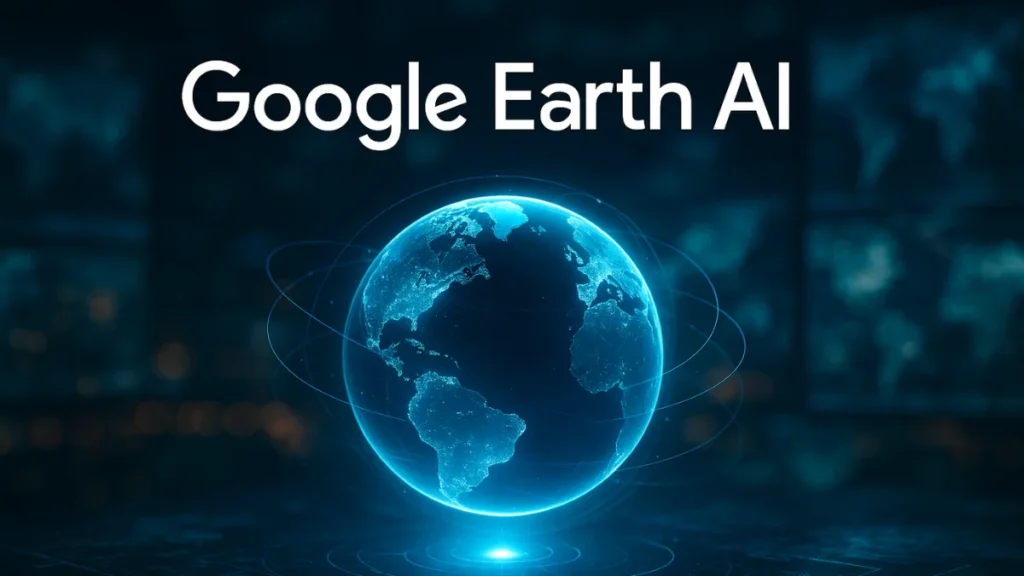The world just got smarter—and more responsive.
Google today announced major updates to its Google Earth AI platform, adding a new geospatial reasoning layer and opening access beyond select pilots. These changes promise to sharpen how enterprises, cities and nonprofits anticipate floods, wildfires and environmental risks across the planet.
Key Takeaways
- Google Earth AI now links satellite, population and weather data in one workflow.
- Geospatial Reasoning, powered by Gemini, makes it possible to ask “what-if” questions about disasters.
- New Enterprise and U.S. Professional access opens the door to broader use.
- Real-world pilots include flood forecasting for 2 billion people and wildfire alerts in California.
- The global impact: faster decision making for non-profits, governments and businesses.
Google Earth AI is a suite of geospatial models from Google that now features “Geospatial Reasoning” to connect weather, imagery, population and infrastructure data. It enables analysts to ask natural-language questions like “Which communities face dust-storm risk?” and get rapid answers. The 2025 update also expands access via Google Cloud and Google Earth Professional.
What’s new with Google Earth AI
Connecting the dots with Geospatial Reasoning
Instead of treating satellite imagery, weather forecasts and population maps as separate silos, Google introduces a unified framework called “Geospatial Reasoning.” This allows the AI system (powered by Gemini) to orchestrate multiple models, turning a question like “Which communities will a storm hit, and what infrastructure is vulnerable?” into a multi-step analysis.
For example, humanitarian group GiveDirectly uses the system to overlay flood-forecast zones with population density maps to identify where aid should go fastest.
Deeper insights right in Google Earth
Google is embedding new Earth AI models directly into Google Earth (Professional and Advanced tiers) so that users can ask simple, conversational questions and get actionable insights.
Examples include:
- A utility company asking: “Find where this river has dried up” → flagging dust-storm risk.
- An analyst querying: “Show me algae blooms in drinking-water sources” → enabling pre-emptive health warnings.
In the U.S., Google AI Pro and Ultra subscribers can access these capabilities immediately; Professional & Professional Advanced users will see roll-out in the coming weeks.
Bringing Earth AI to Google Cloud
The models for Imagery, Population and Environment are now offered via trusted-tester programs on Google Cloud — allowing businesses to bring their own data and combine it with Google’s global datasets.
Major pilots already underway:
- World Health Organization Regional Office for Africa uses population & environment models to predict cholera-risk zones in DRC.
- Satellite-imagery firms like Planet Labs and Airbus employ Earth AI for deforestation mapping and power-line monitoring.
- Bellwether (part of Alphabet’s X) uses the models to improve hurricane-risk analyses for insurers.
Why it matters
A step change in disaster response
Google states their flood-forecasting models already cover more than two billion people. And during 2025’s California wildfires, crisis alerts reached 15 million people in Los Angeles via Google Maps and Search.
By equipping organisations with faster, data-driven insights, the time from detection to action shrinks — potentially saving lives, accelerating relief and reducing cost.
Enterprise and global implications
Geospatial data is fast becoming a strategic asset: insurers, utilities, governments, NGOs all want better situational awareness. Google’s enhancements place it in direct competition with niche geospatial intelligence providers — but with scale and global footprints.
What this means for everyday users
For most consumers, you might not see new features in your regular Google Maps right away — but behind the scenes, these models improve accuracy of alerts, disaster notifications and environmental monitoring. Over time this can mean earlier warnings, more precise location-based insights and deeper context when things go wrong.
Risks and wider context
Access and equity
At present, key features (Geospatial Reasoning, Gemini in Google Earth) are limited: U.S. only, professional tiers, trusted testers. Global rollout is hinted but no concrete timeline.
Data privacy and ethics
When you merge satellite data, population dynamics and infrastructure layers, you’re dealing with sensitive location-based information. Who has access, how is consent handled, what about vulnerable communities? These questions remain.
Competition and market dynamics
By stepping into enterprise geospatial intelligence, Google raises the stakes for competitors. However, differentiation will hinge on how well the models perform in region-specific contexts (e.g., India, Africa), and whether local regulations / data sovereignty issues permit broad adoption.
What’s next
- Google invites organisations (especially in social impact & nonprofit sectors) to sign up as Trusted Testers for Geospatial Reasoning and Earth AI.
- Over the coming months, expect deployment beyond the U.S., and deeper integration into Google Cloud services, BigQuery exposed datasets, and more open APIs.
- Region-specific case studies: we should watch for adoption in India, Southeast Asia, Africa — where climate risk is high, and data infrastructure differs.
Conclusion
Google Earth AI’s update signals a major shift: from siloed models to integrated geospatial intelligence. For enterprises, governments and aid organisations, this could mean faster, more accurate insights into disasters, climate events and infrastructure risks. For the rest of us, the benefits may be less obvious — yet they’re still real: better alerts, smarter maps, quicker responses when things go wrong.
